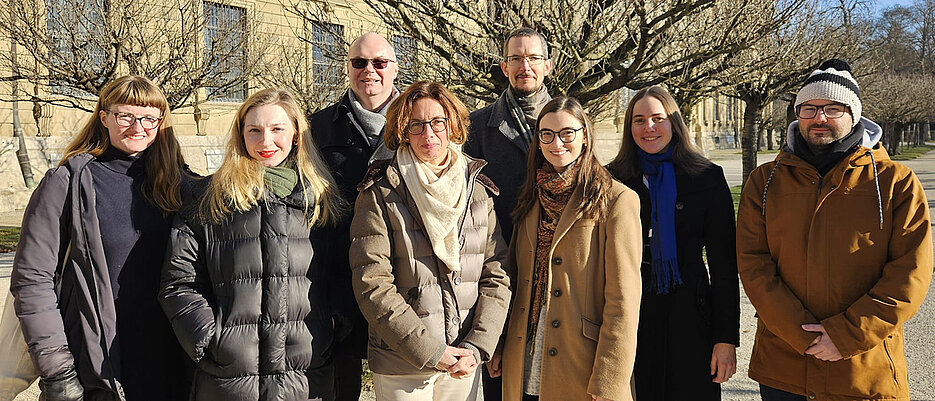How did local people get organized in the ancient world? This is the subject of a new research project at the University of Würzburg involving Theology, Philology and History.

Did the citizens of Rome know associations? Did inhabitants of Jerusalem set up grassroots movements? Did the regular patrons of an Athenian pub discuss the latest political decision-making? The question how neighborhood people formed groups in order to assert themselves and to pursue shared interests is difficult to answer two thousand years later. One of the reasons is that this topic has hardly been investigated by researchers so far.
1.4 million Euros from the DFG
In order to fill this gap, a new research project at the Julius-Maximilians-Universität Würzburg (JMU) is now focusing on these issues: "Locality and Society: Horizontal Binding Forces in Antiquity". The researchers involved are interested in self-governing groups in local governance constellations during a period of roughly 1,000 years. The Deutsche Forschungsgemeinschaft (DFG) is funding the project with approximately 1.4 million euros over the next three years.
"When individuals have common needs, they often join together. In a group, it is easier to pursue shared interests and, if necessary, to assert them against resistance from other societal actors. In the city of Rome, for example, riots and violent clashes destabilized public security during the first century BC. This led to the formation of vigilante groups to protect life and order. From the perspective of their opponents, however, these were mere gangs that caused even more insecurity," says Professor Rene Pfeilschifter, describing the background of the research project.
Local Authorities, Local Civil Society, Local Self-Governance
Professor Barbara Schmitz, holder of the Chair of Old Testament and Biblical-Oriental Languages, Professor Jan Stenger, holder of the Chair of Classical Philology I with a focus on Greek Studies, and Pfeilschifter, holder of the Chair of Ancient History, initiated the interdisciplinary network at JMU, which is organized into three sub-projects. Specifically, these are, in order of research period:
- "Self-organization and horizontal binding forces: local authorities in ancient Judaism from the 6th century BC to the 1st century AD" under the direction of Barbara Schmitz.
- "Horizontal binding forces, state regulation and local civil society: the city of Rome and western Asia Minor in the late Republic", led by Rene Pfeilschifter.
- "Monasticism and local self-organization: monastic letters, horizontal binding forces, and urban community in late antiquity". Jan Stenger is responsible.
Horizontal Binding Forces Instead of Top-Down Regulation
Societal cohesion is rarely the result of top-down attempts at regulation, but also depends on forms of local self-governance. "A good example are local authorities in ancient Judean communities. What makes them special is that they were mostly informal and collegial in organization and had been shaping governance processes at the local level for centuries - in very different places and under different forms of statehood," explains Barbara Schmitz.
Even though the groups analyzed in the three sub-projects were active in various time periods, they still share a number of common characteristics. "For example, the members themselves established and maintained the institutional order of their group, whether formally or informally," explains Schmitz. Furthermore, the roles and functions of members were not permanently assigned but were, at least in principle, interchangeable.
Christian Monks as Advisors
Self-governing groups were dominated by horizontal binding forces. In consequence, they were at odds with the hierarchical world of ancient societies. Instead of the usual authoritative state regulation, plurality and self-organization prevailed. "In Gaza and Egypt, for example, we can use numerous surviving letters to investigate the establishment and functioning of local self-governance in the late Roman Empire," says Jan Stenger. "Local groups there tried to address internal problems and conflicts in community building by asking Christian monks nearby for advice. If this was successful, the horizontal ties within the group could be strengthened without intervention of elites and authorities from above."
The research network is thus shifting the focus from vertical patronage relationships to the plurality of local, self-governing groups. By doing so, the participants hope to challenge the still dominant idea of ancient societies as being extremely top-down oriented institutional arrangements.
"The overarching goal of the project is to use individual case studies to show how horizontal binding forces influenced the cohesion and functioning of society at the local level in the rather hierarchically structured governance constellations of antiquity," explains Stenger.
The Basis of Social Cohesion
Under what conditions did horizontal binding forces become effective? Which social mechanisms integrated the associations of individuals? What role did these self-organizing groups play in local arrangements of order? The research teams want to answer these and many other questions in the coming years.
"We are working on the assumption that horizontal binding forces, being at odds with society at large, did not only generate tensions that had to be overcome by local societies," says Pfeilschifter. Rather, it is conceivable that even, and perhaps especially, in the predominantly hierarchically oriented orders of antiquity, social cohesion depended to a greater or lesser extent on horizontal binding forces.
This model forms the basis of the three differently profiled projects from Ancient History, Old Testament and Classical Philology. The case studies are situated in different eras and different regions. The aim is to provide exemplary historical concretizations within a wide range of conceivable and actual constellations rather than representativeness.






